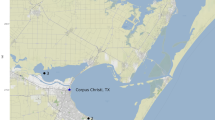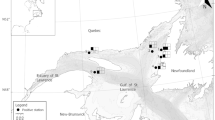Abstract
We describe the development and testing of qPCR assays to detect four species of amphibians and reptiles of conservation concern in the South Central United States through environmental DNA (eDNA) samples. The target species include the Ringed Salamander (Ambystoma annulatum), Three-toed Amphiuma (Amphiuma tridactylum), Crawfish Frog (Rana areolata), and Chicken Turtle (Deirochelys reticularia). A set of primers and probes amplifying a 64–72 bp target regions were designed for each species from DNA sequence data for either the mitochondrial Cytochrome Oxidase I or Cytochrome B gene. All assays were assessed for target specificity, with no evidence of amplification in closely related or sympatrically-distributed non-target species. In vitro tests indicate that all assays consistently detect focal species down to concentrations of 2 × 10− 9 pg/µL. We evaluated the utility of qPCR assays on the eDNA samples collected during field surveys across Eastern Oklahoma, focusing on counties with vouchered historical records for the target species. Although detection rates were low for field applications of the assays, positive detection of Ambystoma annulatum, Rana areolata, and Deirochelys reticularia, but not Amphiuma tridactylum, were recorded. These assays can provide a practical tool for a non-invasive, genetic monitoring program that allows for both rapid detection and tracking of native aquatic and semi-aquatic amphibian and reptile species of conservation concern.
Similar content being viewed by others
References
Adams CIM, Hoeskstra LA, Muell MR, Janzen FJ (2019) A brief review of non-avian reptile environmental DNA (eDNA), with a case study of painted turtle (Chrysemys picta) eDNA under field conditions. Diversity 11(4):50. https://doi.org/10.3390/d11040050
Briggler JT, Johnson JE, Rambo DD (2004) Demographics of a ringed salamander (Ambystoma annulatum) breeding migration. Southwest Nat 49(2):209–217
Bohmann K, Evans A, Gilbert MTP, Carvalho GR, Creer S, Knapp M, Yu DW, de Bruyn M (2014) Environmental DNA for wildlife biology and biodiversity monitoring. Trends Ecol Evol 29(6):358–367. https://doi.org/10.1016/j.tree.2014.04.003
Buhlmann KA, Gibbons JW, Jackson DR (2008) Deirochelys reticularia (Latreille 1801) – chicken turtle. In: Rhodin AGJ, Pritchard PCH, van Dijk PP, Saumure RA, Buhlmann KA, Iverson JB (Eds.). Conservation Biology of Freshwater Turtles and Tortoises: A Compilation Project of the IUCN/SSC Tortoise and Freshwater Turtle Specialist Group. Chel Res Monogr 5: 014.1–014.6. https://doi.org/10.3854/crm.5.014.reticularia.v1.2008
Buxton AS, Groombridge JJ, Griffiths RA (2017) Is the detection of aquatic environmental DNA influenced by substrate type? PLOS ONE 12(8):e0183371. https://doi.org/10.1371/journal.pone.0183371
Esselstyn JA, Garcia JD, Saulog MG, Heaney LR (2008) A new species of Desmalopex (Pteropodidae) from the Philippines, with a phylogenetic analysis of the Pteropodini. J Mammal 89:815–825. https://doi.org/10.1644/07-MAMM-A-285.1
Ficetola GF, Manenti R, Taberlet P (2019) Environmental DNA and metabarcoding for the study of amphibians and reptiles: species distribution, the microbiome, and much more. Amphibia-Reptilia 40(2):129–148. https://doi.org/10.1163/15685381-20191194
Fontenot CL Jr (1999) Reproductive biology of the aquatic salamander Amphiuma tridactylum in Louisiana. J Herpetol 33(1):100–105
Gibbons JW (1970) Terrestrial activity and the population dynamics of aquatic turtles. Am Midl Nat 83:404–414
Heemeyer JL, Williams PJ, Lannoo MJ (2012) Obligate crayfish burrow use and core habitat requirements of crawfish frogs. J Wildlife Manage 75(5):1084–1091. https://doi.org/10.1002/jwmg.357
Hobbs J, Round JM, Allison MJ, Helbing CC (2017) Expansion of the known distribution of the coastal tailed frog, Ascaphus truei, in British Columbia, Canada, using robust eDNA detection methods. PLOS ONE 14(3): e0213849. https://doi.org/10.1371/journal.pone.0213849
Kamoroff C, Goldberg CS (2018) An issue of life or death: using eDNA to detect viable individuals in wilderness restoration. Freshw Sci 37(3):685–696. https://doi.org/10.1086/699203
McKnight DT, Harmon JR, McKnight JL, Ligon DB (2015) The spring–summer nesting and activity patterns of the western chicken turtle (Deirochelys reticularia miaria). Copeia 103(4):1043–1047. https://doi.org/10.1643/CE-15-262
Oklahoma Department of Wildlife Conservation (2016) Oklahoma Comprehensive Wildlife Conservation Strategy. Strategic Conservation Plan for Oklahoma’s Rare & Declining Wildlife. https://www.wildlifedepartment.com/sites/default/files/Oklahoma%20Comprehensive%20Wildlife%20Conservation%20Strategy_0.pdf. Accessed 4 April 2018
Pilliod DS, Goldberg CS, Arkle RS, Waits LP (2014) Factors affecting detection of eDNA from a stream-dwelling amphibian. Mol Ecol Resour 14(1):109–116. https://doi.org/10.1111/1755-0998.12159
Semlitsch RD, Anderson TL, Osbourn MS, Ousterhout BH (2014) Structure and dynamics of ringed salamander (Ambystoma annulatum) populations in Missouri. Herpetologica 70(1):14–22. https://doi.org/10.1655/HERPETOLOGICA-D-13-00074
Stoeckle BC, Beggel S, Cerwenka AF, Motivans E, Kuehn R, Geist J (2017) A systematic approach to evaluate the influence of environmental conditions on eDNA detection success in aquatic ecosystems. PLOS ONE 12(12):e0189119. https://doi.org/10.1371/journal.pone.0189119
Strickler KM, Fremier AK, Goldberg CS (2015) Quantifying effects of UV-B, temperature, and pH on eDNA degradation in aquatic microcosms. Biol Conserv 183:85–82
Williams PJ, Robb JR, Karns DR (2012) Habitat selection by crawfish frogs (Lithobates areolata) in a large mixed grassland/forest habitat. J Herpetol 46(4):682–688. https://doi.org/10.1670/11-144
Wineland SM, Arrick RF, Welch SM, Pauley TK, Mosher JJ, Apodaca JJ, Olszack M, Holmes JN, Waldron JL (2019) Environmental DNA improves eastern hellbender (Cryptobranchus alleganiensis alleganiensis) detection over conventional sampling methods. Environ DNA 1:86–96. https://doi.org/10.1002/edn3.9
Acknowledgements
This research was supported by grants from the Research Council of the University of Oklahoma (OU) Norman Campus to CDS, an ODWC (F16AF01213 [T-91-R-1]) grant to CDS, JLW, TY, and LS. Additional financial support for assay development was provided by an OU Graduate Student Senate award to ESF. No live animals were impacted as part of this research; all tissue samples or DNA extracts were obtained from freezer stocks of previously captured live animals, collected on necessary Institutional Animal Care and Use Committee (IACUC) approvals and state collecting permits at time of capture. The authors thank the members of the Siler Lab and Souza Lab for fieldwork and DNA extraction assistance. We thank the various land managers of Army Corps of Engineers lakes, National Wildlife Refuges, Oklahoma State Parks, The Nature Conservancy, and ODWC Wildlife Management Areas for allowing access to researchers for water sample collection. We thank the following entities and people for loaning us tissue samples: Florida Museum of Natural History (FLMNH) Genetic Resources Repository (GRR), Louisiana State University Museum of Zoology (LSUMZ) Genetic Resources Collection, Sam Noble Museum (OMNH) Oklahoma Collection of Genomic Resources (OCGR), and Dr. Day Ligon of Missouri State University. Lastly, we thank anonymous reviewers for their critical evaluations of this manuscript.
Author information
Authors and Affiliations
Contributions
CDS, JLW, TY, and LS contributed to study conception and design. CDS, JLW, TY, and LS secured funding for assay development, testing, and field survey work, with additional funding secured by ESF for assay development. All authors contributed to field surveys. Assay development was undertaken by ESF and TY. DNA extractions and screening were overseen by JLW, TY, ESF, and CDS. Data analysis and summary of the eDNA sample screening were performed by JLW, with contributions from CDS. The first draft of the manuscript was written by CDS and JLW, with contributions and reviews by ESF, TY, and LS. All authors read and approved the final manuscript.
Corresponding author
Additional information
Publisher's Note
Springer Nature remains neutral with regard to jurisdictional claims in published maps and institutional affiliations.
Electronic supplementary material
Below is the link to the electronic supplementary material.
Rights and permissions
About this article
Cite this article
Siler, C.D., Freitas, E.S., Yuri, T. et al. Development and validation of four environmental DNA assays for species of conservation concern in the South-Central United States. Conservation Genet Resour 13, 35–40 (2021). https://doi.org/10.1007/s12686-020-01167-3
Received:
Accepted:
Published:
Issue Date:
DOI: https://doi.org/10.1007/s12686-020-01167-3




